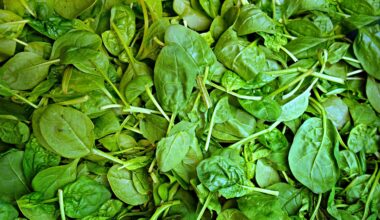The Role of Omega Fatty Acids in Managing Cat Food Allergies
Cats, like many other pets, can have food allergies that lead to various health issues. Understanding common allergens is essential in managing these health problems effectively. Some frequent triggers include proteins like chicken, beef, and fish. Other potential allergens include dairy, soy, and specific grains. Allergies often manifest as skin irritations, gastrointestinal distress, and even respiratory issues. Early identification of these allergens can significantly improve a cat’s quality of life. In addition to avoiding allergens, pet owners need to manage their cat’s overall dietary health. Incorporating specific nutrients, such as omega fatty acids, can help. Omega-3 and omega-6 fatty acids play critical roles in reducing inflammation associated with food allergies. These fatty acids also enhance skin and coat health, making them vital in any cat’s diet. Some veterinary diets are already enriched with omega fatty acids to address these issues. Educating oneself on the potential dietary components is key. This knowledge enables cat owners to select the best nutrition for their beloved pets while addressing allergy concerns.
Omega fatty acids are derived from various sources, making them a convenient option for most diets. For instance, fish oil is a well-known source high in omega-3 fatty acids. There are also plant-based sources, such as flaxseed oil, that can be beneficial. While omega-3s have been frequently highlighted, omega-6s also play an essential role in a cat’s nutritional balance. This fatty acid supports the skin’s barrier function, preventing moisture loss. Ensuring that your cat gets an appropriate ratio of these fatty acids can influence their overall health positively. It is vital to provide consistent meals that include these beneficial oils. Regular supplementation can also enhance a cat’s immune response, particularly when dealing with food allergies. When seeking a suitable cat food, look for labels that mention omega-3 or omega-6 enriched formulations. Authorities recognize the impact of omega fatty acids in nutritionally complete diets. Combining omega fatty acids with hypoallergenic proteins may yield optimal results for allergic cats. Always consult with a veterinarian to determine the best course of action.
Understanding the Benefits of Omega Fatty Acids
Products containing omega fatty acids provide several health benefits for cats suffering from food allergies. Among the most notable advantages is the reduction of inflammation. When cats experience allergic reactions, inflammation can occur, impacting their overall well-being. The incorporation of omega fatty acids can aid in mitigating these inflammatory responses, leading to more comfort and less itching. Additionally, a healthy intake of these fatty acids often results in improved coat condition and skin health. Pet owners will frequently observe shinier fur and less flaking skin when their cats consume adequate omega fatty acids. Furthermore, these nutrients support various other bodily functions, such as hormone regulation and cell membrane integrity. Ensuring cats receive adequate omega fatty acids might not only help manage food allergies but can enhance their overall vitality. Gradually introducing these nutrients into their diet is advisable to ensure acceptance. Alternatives like fortified treats or special prescription diets can assist in this integration. It’s important to maintain consistency while monitoring your cat’s condition during this adjustment phase.
When addressing food allergens, it’s crucial to include omega fatty acids alongside other dietary adjustments. Eliminating suspected allergens is the first step, followed by gradual reintroduction to identify specific triggers. While monitoring reactions, continue to assess omega fatty acid supplementation as an integral part of the nutritional strategy. The transition can take time; hence, it’s beneficial to be patient and attentive. Tracking the overall response to dietary changes will provide valuable insights over time. A uniform approach helps pet owners differentiate food allergies from other health conditions effectively. Relying on veterinary guidance will facilitate a clearer path toward managing allergies while maintaining nutritional balance. Various dermatological and gastrointestinal symptoms often mimic food allergy issues, further complicating diagnosis. In such cases, keeping a food diary may assist in identifying patterns that require attention. This diary can serve as a tool for evaluating reactions and consulting with your veterinarian. Ultimately, the goal is to reach an optimal balance between comfort and quality of life for allergenic cats. Being proactive and informed allows for better decision-making in catering to your cat’s unique needs.
Choosing the Right Cat Food
Choosing the right cat food can dramatically influence how well a cat manages its allergies. The appropriate food must cater not only to allergenic concerns but also provide balanced nutrition, including necessary fatty acids. Commercial cat food often has different formulations designed specifically for allergic cats. Look for products labeled as ‘hypoallergenic,’ which typically contain novel protein sources. These proteins help avoid common allergens, reducing allergic reactions. Ensure that the fatty acids contained within these diets are primarily derived from high-quality sources. Investigate whether the food formulation includes added omega-3 and omega-6 fatty acids and the accompanying benefits. High-quality brands often display rich nutritional profiles, allowing pet owners to make more informed choices. Reading ingredient lists will ensure that there are no unknown additives that may potentially trigger reactions. Regardless of the chosen diet, the transition should be made gradually to avoid gastrointestinal upset. Consulting with a veterinarian regarding specific brands or options tailored for your cat’s health condition is invaluable, leading to beneficial dietary decisions for managing food allergies effectively.
Monitoring your cat’s health after dietary changes is essential for assessing the effectiveness of the new food. Regular check-ups with a veterinarian can help track progress and ensure the diet remains appropriate for managing food allergies. If signs of allergic reactions continue to persist or reoccur, further investigations might include allergy testing or dietary trials. Adjusting portion sizes and the frequency of meals can also influence how well your cat tolerates its new diet. Introducing new foods slowly allows the digestive system to adapt without causing distress. Cats are creatures of habit, often requiring time to accept new flavors or textures. Using positive reinforcement during meal times may encourage a smoother transition. Engage them during feeding with affection, making it a special time. Tracking changes in behavior and coat quality provides further insights into your cat’s response to dietary modifications. Glycemic response may also improve on a well-balanced diet enriched with omega fatty acids. Pet owners can take active steps to ensure their furry friends lead comfortable, healthy lives while managing food allergies effectively.
The Importance of Professional Guidance
Seeking the expertise of professionals in cat nutrition can alleviate many concerns when managing food allergies. Veterinarians and pet nutritionists offer tailored solutions rooted in scientific understanding and a deep awareness of individual pet needs. Working closely with experienced professionals allows for real-time adjustments that can enhance your cat’s dietary management. Sometimes, prescriptions may be necessary to treat underlying health issues exacerbated by food allergies. While home care can involve diet adjustments, professional oversight ensures a comprehensive approach. Additionally, cases that involve multiple allergies may require more complex solutions. Frequent consultations help to modify any ongoing plans based on the cat’s reactions and shifting needs. A trusted source of information can clarify any doubts regarding quality ingredients and dietary compositions. The importance of ongoing education cannot be overstated. Programs or literature focusing on pet nutrition can empower owners to navigate the evolving landscape of cat care effectively. Proper knowledge leads to informed choices which ultimately enhance the welfare of our feline companions. Therefore, establishing a solid relationship with professionals is highly advantageous for managing food allergies in cats.
In conclusion, managing cat food allergies requires a multifaceted approach that incorporates understanding allergens, the benefits of omega fatty acids, and personalized veterinary care. Owners need to be vigilant and proactive in assessing their cat’s dietary needs and potential allergens. The road to dietary management may appear complex, but the end result is a happier and healthier pet. Omega fatty acids offer significant benefits when included in their diet, helping mitigate painful symptoms caused by food allergies. Choosing high-quality food with added omega supplementation can greatly enhance a cat’s overall well-being while reducing allergic reactions. Monitoring reactions to new foods, maintaining clear communication with veterinarians, and making informed adjustments to diet play crucial roles. Thus, a supportive network of professionals, family, and pet owners can help facilitate this journey. Being proactive in your cat’s nutritional health fosters an engaging and productive environment for optimal longevity and quality of life. As you embrace these strategies, you provide your feline friends with the best care possible. Taking steps today ensures a brighter future for all our beloved cats suffering from allergies.


